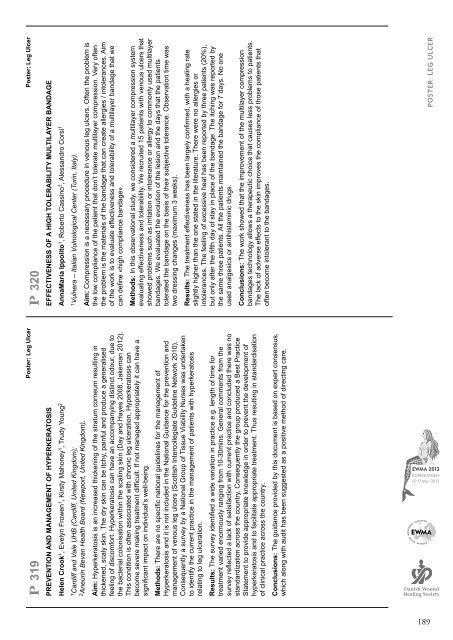Create successful ePaper yourself
Turn your PDF publications into a flip-book with our unique Google optimized e-Paper software.
POSTER: LEG ULCER<br />
Poster: Leg Ulcer<br />
P 319<br />
Prevention and Management of Hyperkeratosis<br />
Helen Crook 1 , Evelyn Frowen 1 , Kirsty Mahoney 1 , Trudy Young 2<br />
1 Cardiff and Vale UHB (Cardiff, United Kingdom);<br />
2 Aneurin Bevan Health Board (Newport, United Kingdom).<br />
Aim: Hyperkeratosis is an increased thickening of the stratum corneum resulting in<br />
thickened, scaly skin. The dry skin can be itchy, painful and produce a generalised<br />
feeling of discomfort. Hyperkeratosis can have an accompanying distinct odour, due to<br />
the bacterial colonisation within the scaling skin (Day and Hayes 2008, Jakeman 2012).<br />
This condition is often associated with chronic leg ulceration. Hyperkeratosis can<br />
become severe making treatment difficult. If not managed appropriately it can have a<br />
significant impact on individual’s well-being.<br />
Methods: There are no specific national guidelines for the management of<br />
Hyperkeratosis and it is not included in the National Guidance for the prevention and<br />
management of venous leg ulcers (Scottish Intercollegiate Guideline Network 2010).<br />
Consequently a survey by a National Group of Tissue Viability Nurses was undertaken<br />
to identify the current practice in the management of patients with hyperkeratosis<br />
relating to leg ulceration.<br />
Results: The survey identified a wide variation in practice e.g. length of time for<br />
treatment varied enormously ranging from 10-30mins. General comments from the<br />
survey reflected a lack of satisfaction with current practice and concluded there was no<br />
standardization across the country. Consequently the group produced a Best Practice<br />
Statement to provide appropriate knowledge in order to prevent the development of<br />
hyperkeratosis and to facilitate appropriate treatment. Thus resulting in standardisation<br />
of clinical practice across the country.<br />
Conclusions: The guidance provided by this document is based on expert consensus,<br />
which along with audit has been suggested as a positive method of directing care.<br />
P 320<br />
EFFECTIVENESS OF A HIGH TOLERABILITY MULTILAYER BANDAGE<br />
Poster: Leg Ulcer<br />
AnnaMaria Ippolito 1 , Roberto Cassino 1 , Alessandro Corsi 1<br />
1 Vulnera – Italian Vulnological Center (Turin, Italy).<br />
Aim: Compression is a necessary procedure in venous leg ulcers. Often the problem is<br />
the low compliance of the patient that don’t tolerate multilayer compression. Very often<br />
the problem is the materials of the bandage that can create allergies / intolerances. Aim<br />
of the work is to evaluate effectiveness and tolerability of a multilayer bandage that we<br />
can define «high compliance bandage».<br />
Methods: In this observational study, we considered a multilayer compression system<br />
evaluating effectiveness and tolerability. We recruited 15 patients with venous ulcers that<br />
showed problems such as irritation or intolerance or allergy to commonly used multilayer<br />
bandages. We evaluated the evolution of the lesion and the days that the patients<br />
tolerated the bandage on the basis of their subjective tolerance. Observation time was<br />
two dressing changes (maximum 3 weeks).<br />
Results: The treatment effectiveness has been largely confirmed, with a healing rate<br />
slightly higher than the one stated in the literature. There were no allergies or<br />
intolerances. The feeling of excessive heat has been reported by three patients (20%),<br />
but only after the fifth day of stay in place of the bandage. The itching was reported by<br />
the same three patients. All the patients maintained the bandage for 7 days. No one<br />
used analgesics or antihistaminic drugs.<br />
Conclusions: The work showed that the improvement of the multilayer compression<br />
bandages technology allows a therapeutic choice that causes less problems to patients.<br />
The lack of adverse effects to the skin improves the compliance of those patients that<br />
often become intolerant to the bandages.<br />
<strong>EWMA</strong> <strong>2013</strong><br />
COPENHAGEN<br />
15-17 May · <strong>2013</strong><br />
Danish Wound<br />
Healing Society<br />
189






